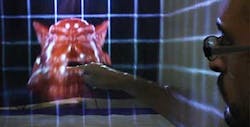University of Bristol scientists have developed a three-dimensional (3D) tabletop display with personal screens made from projectors illuminating a curtain of mist that allows users to move images around and push through the fog-screens and onto the display. The research paper, to be presented at one of the world's most important conferences on human-computer interfaces, ACM CHI 2014 (26 April-1 May), will describe how the display could change the way people interact and collaborate in the future.
RELATED ARTICLE: 3D digital holograms visualize biomedical applications
MisTable, led by professors Sriram Subramanian and Diego Martinez Plasencia from the University of Bristol's Department of Computer Science, is a tabletop system that combines a conventional interactive table with personal screens, built using fog, between the user and the tabletop surface. These personal screens are both see-through and reach-through. The see-through feature provides direct line of sight of the personal screen and the elements behind it on the tabletop. The reach-through feature allows the user to switch from interacting with the personal screen to reaching through it to interact with the tabletop or the space above it.
The personal screen allows a range of customizations and novel interactions such as presenting 2D personal content on the screen, 3D content above the tabletop or supplementing and renewing actual objects differently for each user (see video below):
Sriram Subramanian said, "MisTable broadens the potential of conventional tables in many novel and unique ways. The personal screen provides direct line of sight and access to the different interaction spaces. Users can be aware of each other's actions and can easily switch between interacting with the personal screen to the tabletop surface or the interaction section. This allows users to break in or out of shared tasks and switch between 'individual' and 'group' work." He adds, "Users can also move content freely between these interaction spaces. Moving content between the tabletop and the personal screen allow users to share it with others or to get exclusive ownership over it."
SOURCE: University of Bristol; http://www.bristol.ac.uk/news/2014/april/mistable.html

Gail Overton | Senior Editor (2004-2020)
Gail has more than 30 years of engineering, marketing, product management, and editorial experience in the photonics and optical communications industry. Before joining the staff at Laser Focus World in 2004, she held many product management and product marketing roles in the fiber-optics industry, most notably at Hughes (El Segundo, CA), GTE Labs (Waltham, MA), Corning (Corning, NY), Photon Kinetics (Beaverton, OR), and Newport Corporation (Irvine, CA). During her marketing career, Gail published articles in WDM Solutions and Sensors magazine and traveled internationally to conduct product and sales training. Gail received her BS degree in physics, with an emphasis in optics, from San Diego State University in San Diego, CA in May 1986.
